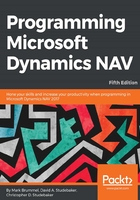
上QQ阅读APP看书,第一时间看更新
NAV functional terminology
For various application functions, NAV uses terminology more similar to accounting than to traditional data processing terminology. Here are some examples:
- Journal: A table of unposted transaction entries, each of which represents an event, an entity, or an action to be processed. There are General Journals for general accounting entries, Item Journals for changes in inventory, and so on.
- Ledger: A detailed history of posted transaction entries that have been processed. For example, General Ledger, Customer Ledger, Vendor Ledger, Item Ledger, and so on. Some ledgers have subordinate detail ledgers, typically providing a greater level of quantity and/or value detail. With minor exceptions, ledger entries cannot be edited. This maintains auditable data integrity.
- Posting: The process by which entries in a journal are validated, and then entered into one or more ledgers.
- Batch: A group of one or more journal entries posted at the same time.
- Register: An audit trail showing a history, by Entry Number ranges, of posted Journal Batches.
- Document: A formatted page such as an Invoice, a Purchase Order, or a Payment Check, typically one page for each primary transaction (a page may require display scrolling to be fully viewed).